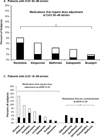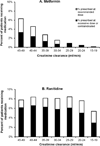Use of Renally Inappropriate Medications in Older Veterans: A National Study
- PMID: 26503124
- PMCID: PMC4733653
- DOI: 10.1111/jgs.13790
Use of Renally Inappropriate Medications in Older Veterans: A National Study
Erratum in
-
Erratum.J Am Geriatr Soc. 2016 Feb;64(2):462. doi: 10.1111/jgs.14081. J Am Geriatr Soc. 2016. PMID: 26889867 No abstract available.
Abstract
Objectives: To determine how many ambulatory older adults with chronic kidney disease receive medications that are contraindicated or dosed excessively given their level of renal function.
Design: Cross-sectional retrospective study.
Setting: U.S. Department of Veterans Affairs (VA) clinics.
Participants: Individuals aged 65 and older with a creatinine clearance (CrCl) of 15 to 49 mL/min (N = 83,850; mean age 80; 96% male).
Measurements: Forty medications that require dose adjustment or are contraindicated in people with impaired renal function were examined. Medication use and CrCl (calculated using the Cockroft-Gault equation) were assessed using VA pharmacy, laboratory, and other data sources as of October 2007.
Results: Thirteen percent of older veterans with a CrCl of 30 to 49 mL/min and 32% of those with a CrCl of 15 to 29 mL/min received one or more drugs that were contraindicated or prescribed at an excessive dose given the individual's level of renal function. The strongest risk factor for renally inappropriate prescribing was number of medications used; the risk of receiving renally inappropriate medications was 5.5 times as high (95% confidence interval = 5.1-5.9) in older adults taking 10 or more medications as in those taking one to three medications. Ranitidine, allopurinol, and metformin together accounted for 76% of renally misprescribed medications in individuals with a CrCl of 30 to 49 mL/min. Glyburide, ranitidine, gemfibrozil, carvedilol, and allopurinol accounted for 47% of renally misprescribed drugs for individuals with a CrCl of 15 to 29 mL/min.
Conclusion: Inappropriate prescribing of renally cleared medications is common in ambulatory older veterans, with only a few medications accounting for most of these prescribing problems.
Keywords: chronic kidney disease; drug use; pharmacoepidemiology; quality of care; veterans.
© 2015, Copyright the Authors Journal compilation © 2015, The American Geriatrics Society.
Conflict of interest statement
Figures




Similar articles
-
Potentially inappropriate prescribing of primarily renally cleared medications for older veterans affairs nursing home patients.J Am Med Dir Assoc. 2011 Jun;12(5):377-83. doi: 10.1016/j.jamda.2010.04.008. Epub 2010 Oct 2. J Am Med Dir Assoc. 2011. PMID: 21450179 Free PMC article.
-
Potentially inappropriate prescribing of renally cleared drugs in elderly patients in community and aged care settings.Drugs Aging. 2015 May;32(5):391-400. doi: 10.1007/s40266-015-0261-1. Drugs Aging. 2015. PMID: 25925940
-
Impact of the pharmacist medication review services on drug-related problems and potentially inappropriate prescribing of renally cleared medications in residents of aged care facilities.Drugs Aging. 2014 Nov;31(11):825-35. doi: 10.1007/s40266-014-0208-y. Drugs Aging. 2014. PMID: 25187228
-
Consensus guidelines for oral dosing of primarily renally cleared medications in older adults.J Am Geriatr Soc. 2009 Feb;57(2):335-40. doi: 10.1111/j.1532-5415.2008.02098.x. Epub 2008 Dec 10. J Am Geriatr Soc. 2009. PMID: 19170784 Free PMC article.
-
Medications for community pharmacists to dose adjust or avoid to enhance prescribing safety in individuals with advanced chronic kidney disease: a scoping review and modified Delphi.BMC Nephrol. 2024 Oct 29;25(1):386. doi: 10.1186/s12882-024-03829-y. BMC Nephrol. 2024. PMID: 39472832 Free PMC article.
Cited by
-
Prevalence of polypharmacy and associated adverse health outcomes in adult patients with chronic kidney disease: protocol for a systematic review and meta-analysis.Syst Rev. 2021 Jul 4;10(1):198. doi: 10.1186/s13643-021-01752-z. Syst Rev. 2021. PMID: 34218816 Free PMC article.
-
Pattern, frequency and factors associated with inappropriate high dosing in chronic kidney disease patients at a tertiary care hospital in Pakistan.BMC Nephrol. 2023 May 1;24(1):118. doi: 10.1186/s12882-023-03167-5. BMC Nephrol. 2023. PMID: 37127612 Free PMC article.
-
Renally Inappropriate Medications in the Old Population: Prevalence, Risk Factors, Adverse Outcomes, and Potential Interventions.Cureus. 2023 Nov 20;15(11):e49111. doi: 10.7759/cureus.49111. eCollection 2023 Nov. Cureus. 2023. PMID: 38125263 Free PMC article. Review.
-
Kidney Disease Management in the Hospital Setting: A Focus on Inappropriate Drug Prescriptions in Older Patients.Front Pharmacol. 2021 Oct 8;12:749711. doi: 10.3389/fphar.2021.749711. eCollection 2021. Front Pharmacol. 2021. PMID: 34690782 Free PMC article.
-
Potentially inappropriate prescribing in older adults with advanced chronic kidney disease.PLoS One. 2020 Aug 20;15(8):e0237868. doi: 10.1371/journal.pone.0237868. eCollection 2020. PLoS One. 2020. PMID: 32818951 Free PMC article.
References
-
- Leendertse AJ, van Dijk EA, De Smet PA, Egberts TC, van den Bemt PM. Contribution of renal impairment to potentially preventable medication-related hospital admissions. Ann. Pharmacother. 2012 May;46(5):625–633. - PubMed
-
- Dong K, Quan DJ. Appropriately assessing renal function for drug dosing. Nephrol. Nurs. J. 2010 May-Jun;37(3):304–308. - PubMed
-
- Steinman MA, Landefeld CS, Rosenthal GE, Berthenthal D, Sen S, Kaboli PJ. Polypharmacy and prescribing quality in older people. J. Am. Geriatr. Soc. 2006 Oct;54(10):1516–1523. - PubMed
Publication types
MeSH terms
Substances
Grants and funding
LinkOut - more resources
Full Text Sources
Other Literature Sources
Medical

